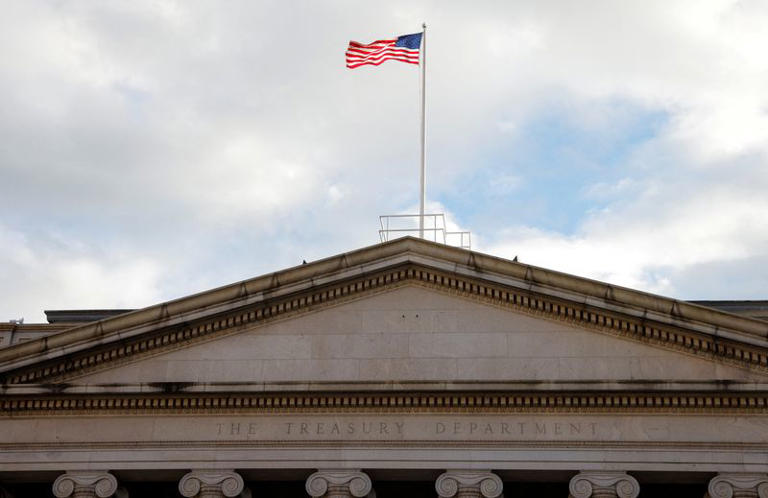A recent study conducted by Hudson Bay Capital Management has stirred considerable debate in the financial community regarding the U.S. Treasury’s bond issuance strategy over the past year. The study, authored by renowned economist Nouriel Roubini and former Treasury advisor Stephen Miran, suggests that the Treasury’s decision to moderate long-dated bond sales effectively provided an economic stimulus. This stimulus, according to their analysis, is comparable to the impact of a one percentage point reduction in the Federal Reserve’s policy rate. The findings have been met with a strong denial from the U.S. Treasury, which asserts that there was no intention to influence economic conditions through their bond issuance policies.
Treasury’s Policy Adjustments and Market Impact
In November 2023, the U.S. Treasury Department announced a strategic slowdown in the pace of increasing auction sizes for long-dated debt securities. This policy shift aimed to provide relief to the bond markets, which had been significantly impacted by previous increases in long-term debt supply. By moderating the issuance of long-dated bonds, the Treasury sought to stabilize the bond market and address investor concerns related to an oversupply of long-term debt.
The Hudson Bay Capital Management study posits that this moderation in bond issuance led to a decrease in 10-year Treasury yields. According to the study, this decline in yields had an economic impact equivalent to that of a one percentage point reduction in the Federal Reserve’s policy rate, effectively acting as a form of economic stimulus. This finding has raised questions about the nature of the Treasury’s intentions and the broader implications of their bond issuance strategy on economic conditions.
Key Findings and Interpretation
Nouriel Roubini, known for his accurate predictions of the global credit crisis, and Stephen Miran, who previously served as an advisor for economic policy at the U.S. Treasury under former Secretary Steven Mnuchin, argue that the Treasury’s actions had a stimulative effect. In an interview, Roubini explained that while the Federal Reserve was actively raising the federal funds rate to cool down the economy, the Treasury’s policies were inadvertently pushing long-term yields lower. This dynamic, Roubini suggests, has led to a “no landing zone” where economic growth remains robust despite efforts to slow it down.
The study also aligns with assertions made by some Republican senators, who claimed that the Treasury’s increased issuance of short-term Treasury bills was designed to provide a temporary economic boost ahead of elections. Roubini’s paper draws a parallel between this strategy and broader concerns about fiscal policy and its impact on economic conditions.
Treasury’s Denial and Official Response
In response to the study’s findings, the U.S. Treasury has categorically denied any intention to influence economic conditions through its bond issuance strategy. Treasury Secretary Janet Yellen, appointed by President Joe Biden, emphasized that the Treasury’s actions were not aimed at easing financial conditions. She stated, “We have never, ever discussed anything of the sort,” firmly rejecting the notion that the Treasury had any strategic intent to provide economic stimulus.
Assistant Secretary for Financial Markets Joshua Frost also addressed misconceptions about Treasury issuance. In a recent speech, Frost argued that the reduction in long-dated debt issuance last year was relatively modest and consistent with the Treasury’s goal of securing the best possible funding conditions for taxpayers. He highlighted that the Treasury’s primary focus was on obtaining favorable funding terms rather than manipulating economic conditions.
Market Reactions and Analytical Perspectives
The comparison of the Treasury’s bond issuance adjustments to quantitative easing—a strategy where the Federal Reserve buys bonds to inject liquidity into the economy—has been met with skepticism by several bond market analysts. Gennadiy Goldberg, head of U.S. rates strategy at TD Securities USA, argued that while the Treasury’s actions may have marginally lowered rates, this effect was aligned with the Treasury’s goal of obtaining cost-effective funding for taxpayers. Goldberg dismissed the idea of a deliberate effort to ease monetary policy as unfounded.
Jonathan Cohn, head of U.S. rates desk strategy at Nomura Securities International, noted that while the Treasury’s actions may not have been intended to time the market, they demonstrated a higher-than-expected sensitivity to market conditions during a volatile period. Cohn emphasized that the Treasury’s approach reflected an awareness of market dynamics rather than ignorance or deliberate manipulation.
Political and Economic Implications
The ongoing debate highlights broader concerns about the intersection of fiscal policy and market dynamics. The controversy reflects the complexities involved in interpreting government actions and their potential impacts on financial markets. The debate also underscores the challenges of balancing economic policy objectives with market expectations and the need for transparency in governmental financial strategies.
As market participants and policymakers continue to analyze the implications of these actions, the discussion serves as a reminder of the delicate balance required in managing fiscal and monetary policy. The controversy also raises important questions about the role of government intervention in financial markets and the potential for unintended consequences in economic policy.
